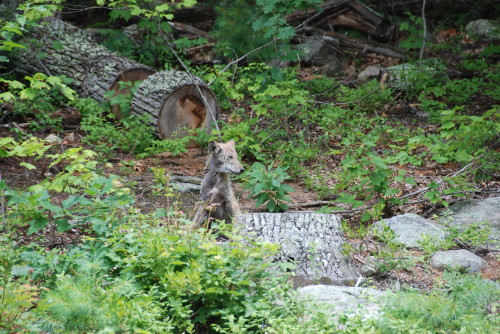Above: sick animal spotted by Middle Road (photo from Deb DeGregorio)
Southborough resident Deb DeGregorio shared information about what appears to be a sickly coyote on Middle Road yesterday.
We’re all aware that there are coyotes in Southborough. But whenever an animal is sickly, it obviously poses a greater threat. So just to make you aware, I’m sharing her information.
Yesterday we spotted this poor guy on the hill [of Mount Vickory by Middle Road]. His right rear leg is injured and he has a limp. He has mange or something; his fur is gone on his right side (you can see this clearly if you zoom in on the pics) and his eye looks terrible too. He was scratching himself for quite a while and then laid down and rested. . . I am pretty sure he is a coyote. (I googled ‘sick coyote’ and saw other images similar to this).
She took some great pictures. Honestly, they make me feel pretty sorry for the fella. (But then, I don’t have children or pets in that neighborhood.)






In May, the Southborough Open Land Foundation had a speaker, who is an animal control officer in Belmont, talk about co-existing with coyotes. He mentioned that he has brought mangy coyotes to Tufts Veterinary Clinic in Grafton where they have nursed them back to good health. He said the service was free of charge, but they do accept donations. He would return to pick up the cured coyote and release it back into his town.
Is it safe to habituate a coyote to humans in that way and then re-release them into populated areas? I appreciate the sentiment, but surely the right thing to do is to humanely put these animals out of their misery.
Chris – It is safe, as described by Dr. Jon Way who studies coyotes as well by John Maguranis, the animal control officer in Belmont. Care is taken to not allow the animal to become “familiar” with humans. How sad this animal continues to suffer and yet unlikely that we, in town, have the “wherewithall” to get him the care he needs. One thing we learned from the presentation of Maguranis is that 95% of the coyote’s diet is small rodents. -and small rodents provide for part of the life-cycle of the deer tick. I agree its a shame to let this animal continue to suffer.
Coyotes do kill many rodents, but they also kill many foxes, cats, weasels, and other rodent killers, so it’s not clear what their net effect on the rodent population is. In any case, coyotes are a poor solution to the rodent problem as they also carry diseases and are too large a predator to be in residential areas with small people, especially children, but also weak, incapacitated, or outnumbered people, not to mention our domesticated animals. This sick coyote should be put down humanely and the resources to help it should be used in other ways.
When you say “humanely” are you telling me that humans dispatch their sick and injured as the context of the adverb implies?
We see this coyote all the time, he’s been limping around here for at least two years.
Think twice before accepting these animals living near your home:
http://www.milforddailynews.com/news/x157636418
Nicholas Cole was lucky his grandfather had the strength to hold this animal down while it continued to bite him.
Coyotes are all over town with no predators.
The coyote population continues to explode. I saw a mother with 2 pups behind my house a few months ago. They move around. If I see them again, they will be humanely removed……
May I suggest you check out this link for more information about coyotes. Start at the bottom of the page and work your way up the postings to see what has happened in Belmont since 2004. Removing a coyote from our town can cause more problems than you would want.
http://www.town.belmont.ma.us/public_documents/BelmontMA_AnimalCtrl/coyotecall?textPage=1
The “mange” may really be shedding. These animals have a thick undercoat to see them through the winter and it comes off just like our dogs.
http://coyoteyipps.com/tag/coyote-shedding/
You might be able to “remove” a single coyote but they are here to stay. When you see one there are a dozen more in the area. We have a field in our neighborhood and when my neighbor shined a spotlight on it one evening there were 3 or 4 sets of red eyes looking at us.
http://www.portal.state.pa.us/portal/server.pt?open=514&objID=598430&mode=2
Leave the poor fella alone. I have seen him for a few years, he’s fine. When I see him he’s always in a good passed trot, when he sees me he picks the pass up. It is disturbing to hear that the police are looking for him with guns drawn and with the intent of putting him down. The police should keep in mind there is no hunting in the town of Southborough with out a land owners permission and that discharging a firearm within 500 ft of a dwelling is illegal. This animal is no where near the condition of being put down. The fact they haven’t been able to get him says that.
alan
I agree. It would be one thing to put him down if he were hit by a car or there was evidence of rabies (which is rare in coyotes) but I hope we are not expending any public effort on this. Coyotes are nocturnal and I doubt that anyone is going to get close enough to “responsibly” dispatch him with a handgun.
If we are going to live with nature then we have to be prepared to let nature take its course.
It does appear that the coyote has mange. Mange can be easily treated, however, whoever embarks on trying to capture him and get him to Tufts will require permission from Mass Fish and Wildlife. The Animal Rescue League may be able to help, as they frequently gain permission to do these types of “rescue”.
Coyotes main diet is rodents, so having them around offers free rodent control. As far as dangers to children that so many express concerns about, there is an extremely low danger of this happening. Coyotes have been in Massachusetts for over 60 years and we have 5 confirmed bites from them. Three of those coyotes had rabies and in comparison to foxes, raccoons and skunks, their numbers are extremely low. Statistically, you are FAR more at risk of getting bit by a dog than a coyote.
Massachusetts killed the last known wolf over 160 years ago. Other top predators were killed off as well, so our ecology has been devoid of a top predator for a long, long time. The balance of nature, health of ecosystems and control of other mesopredators is at risk without predators. Coyotes are filling that niche and it is a good thing in terms of the balance of nature.
I’m with Alan; leave the poor fella alone.
Thanks John and Al.
If someone does see him just let him know you are there by talking as to not to spook him. He will quickly go the other way, away from you. Every time I have seen him this has worked. He doesn’t want any part of humans.
completely agree with leaving him along; however, if he is ill/in pain or diseased and there is a way to help him then I am all for it and would contribute to his well being.
i have seen him on my early morning walks, always in the general same place and the other posters are correct–unless threatened they really are in search of rodents, you are much more likely to be attacked by a dog unless you threaten them or go near their offspring.
Here’s what you can do for him; call Animal Rescue League of Boston and let them know what’s going on. I have worked with them before with rescuing coyotes, so I know if they have the time, they will help out. If their resources prohibit them from assisting, then maybe the Animal Control Officer (I haven’t seen too many who would get involved with this sort of thing, but worth a try).
If neither options work out, you can try contacting Mass Fish & Wildlife and request to have me come try and trap him. I have a box trap big enough for him and will transport him to Tufts Wildlife Clinic for treatment. Keep in mind that he will be released in the same area after he is rehabilitated.
John
Don’t do that. For the same reason you would never feed a coyote, you shouldn’t rehabilitate sick coyotes and release them. It’s dangerous. Just put the animal down as humanely as possible. Put it out of its misery. Don’t take it in and feed it and give it care and release it. It’s too dangerous.
It is absolutely safe and NOT dangerous at all. Wildlife rehabilitators (and Tufts) all know the ramifications of human/food association and special care is always taken to limit human exposure to an absolute minimum. I have personally released several rehabbed coyotes that never got into any trouble afterwards (they were all ear tagged by MF&W so we would know). Coyotes serve an important role in ecosystems and should be considered favorably.
Gotta say, that sounds right to me… I’d imagine the folks at Tufts take a look at the poor animals and decide whether to humanely euthanize them or to attempt a rescue/reintroduction…or to give it to a habitat such as Drumlin Farm. Now, an amateur well-intentioned rescuer taking in a sick animal is a very different story.
You will find that experts universally dis-recommend relocating coyotes.
For example this website says:
“Relocating an animal miles away from its – your – home is akin to you being transported to Chicago with no food, no money, and only the clothes on your back. They have a slim chance of survival against the other animals who already have established territories, who know where to find food, and where to hide from predators.
Moving an animal can also spread disease, not just between the old community and the new, but also between species. Viruses such as distemper and parvo thrive in new hosts. The practice of trapping and relocating animals risks separating mothers from their young and leaving the babies behind to die, or to be raised by financially-strapped rehabilitation centers.”
Rehabbed coyotes are normally released in the same area they were caught in. The one’s that aren’t are relocated in an area where the rehabber has determined to be an area safe for the coyote to live. A lot goes into rehabbing and releasing and is done based on the current science and studies regarding coyotes. Why put in effort and money to rehabilitate an animal and release it where it will die?
Mange?
I don’t think so…
http://www.youtube.com/watch?v=pXI1PDTp5gk
Come on people, it’s not as if its eating the chickens and carrying off small children. Leave it in peace
The idea is whether to help it or leave it sick, not in peace, leave it obviously suffering or to put it down humanely or to try to take it in and “rehabilitate” it and then “relocate” it somewhere else. Peace is not an option for it to be left in if it’s very sick.
And coyotes absolutely attack small children. Just the other day, a child was attacked in an urban cemetery, and a few weeks ago two were attacked in a popular urban park in Colorado. For more, Google the article “Coyote Attacks on Humans in the United States and Canada”. Wikipedia keeps records of such attacks on the article “Coyote Attacks on Humans”, where you can follow the links to the original news stories.
The coyote is a frequent visitor to the our house, he keeps a safe distance and is afraid of our dogs. We like seeing him, everybody has their place in the neighborhood. He most likely plays some role in the cycle of life here – maybe keeps the mice down. I see a lot less ticks and we never see deer behind the house. Personally deer are less welcome here than coyotes and foxes – they eat our berries and bushes! In the last few years so much has changed, I see so many more hawks and herons. I see this topic brings so much emotion and opinion – fear, amusement, admiration! That is a gift the coyote has brought this groups of readers!
Last update on the coyote …
The coyote came to our house two days ago barely alive. My wife saw what looked like wire wrapped around his torso, he was resting on the leaves. Yesterday we looked again and he was gone but most likely he died, he was almost unable to walk. Probably someone tried to catch or harm him and he ended up being tortured and perhaps that is why he looked so horrible.
It’s probably not someone torturing them; it’s just the mange. Coyotes get mange; always have. A lot. Get used to seeing mangy coyotes; I know it’s horrible but let’s as a society get in the habit of having them put down properly; if it were rare we “maybe” could think about helping them but they are everywhere and they are often sick and dying of starvation and so on that’s just the way it is/has always been since they evolved. Mother Nature is just cruel. Let it be a lesson to us: as Hepburn said to Bogart: “Nature, Mr. Alcott, is what we were put on this planet to rise above!”